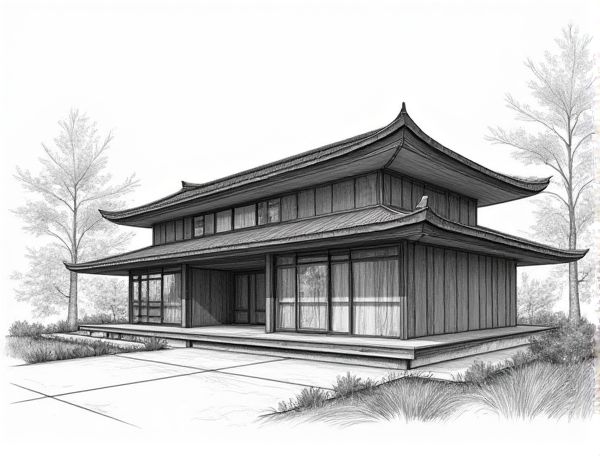
Photo illustration: Japanese home design with shou sugi ban exterior cladding
Embracing the timeless elegance of Japanese home design, shou sugi ban exterior cladding offers a unique combination of durability and natural beauty through its charred wood finish, enhancing your property's aesthetic while providing exceptional weather resistance. Discover more about how this traditional technique can transform your living space by reading the full article.
Introduction to Japanese Home Design Principles
Japanese home design principles emphasize simplicity, natural materials, and harmony with nature, creating tranquil and functional living spaces. Key elements include sliding shoji screens, tatami mat flooring, and minimalistic furniture arrangements that optimize space usage. Incorporating indoor-outdoor connections through gardens and natural light enhances serenity and balance in Japanese interior design.
What is Shou Sugi Ban? A Timeless Japanese Technique
Shou Sugi Ban is a traditional Japanese woodworking technique that involves charring the surface of cedar wood to preserve and protect it from weather, pests, and decay. This method enhances durability while providing a distinctive, textured appearance that ranges from deep black to smoky gray. Popular in modern home design, Shou Sugi Ban adds natural fire resistance and a unique aesthetic that blends rustic charm with contemporary elegance.
Benefits of Shou Sugi Ban Exterior Cladding
Shou Sugi Ban exterior cladding offers exceptional durability and natural resistance to fire, rot, and pests, significantly extending the lifespan of your home's facade. Its unique charred wood finish enhances curb appeal while requiring minimal maintenance, making it an eco-friendly and cost-effective choice for sustainable home design.
Material Selection: Choosing the Right Wood for Shou Sugi Ban
Selecting the right wood for Shou Sugi Ban requires prioritizing durability and grain texture, with Japanese cedar (sugi) being the traditional and most effective option for charred wood preservation. Your choice impacts the aesthetic appeal and longevity of the siding, making it essential to opt for high-quality, well-seasoned timber to ensure optimal resistance to weather and pests.
Step-by-Step Shou Sugi Ban Process for Home Exteriors
The Step-by-Step Shou Sugi Ban process for home exteriors involves charring the wood surface with a flame to create a carbon layer that enhances durability and resistance to pests and weather. After cooling, the wood is brushed to remove soot, rinsed, dried, and sealed with natural oils to preserve the finish and extend the lifespan of the exterior cladding.
Integration of Shou Sugi Ban with Modern Japanese Architecture
Shou Sugi Ban, a traditional Japanese wood preservation technique, enhances modern Japanese architecture by combining natural durability with minimalist aesthetics. Its charred cedar panels offer fire resistance and weatherproofing, seamlessly blending with sleek lines and open spaces characteristic of contemporary designs. Incorporating Shou Sugi Ban improves sustainability while maintaining cultural authenticity in modern home exteriors and interior accents.
Sustainability and Environmental Impact of Charred Wood Cladding
Charred wood cladding significantly reduces environmental impact by utilizing a natural preservation method that enhances durability without toxic chemicals, extending the lifespan of your home exterior and minimizing waste. Its carbon sequestration properties and renewable sourcing contribute to sustainable building practices, aligning with eco-friendly home design goals.
Maintenance Tips for Shou Sugi Ban Facades
To preserve the beauty and durability of Shou Sugi Ban facades, regularly inspect the charred wood surface for any signs of wear or damage and clean it gently with a soft brush to remove dirt and debris. Apply natural oil finishes, such as tung or linseed oil, annually to maintain the wood's protective layer and enhance its weather resistance. Your careful maintenance ensures longevity, preventing moisture damage and preserving the intricate texture characteristic of Shou Sugi Ban.
Inspiring Japanese Homes Featuring Shou Sugi Ban
Shou Sugi Ban, a traditional Japanese wood preservation technique, enhances home design with its distinctive charred wood finishes that provide durability and natural resistance to pests and fire. This method creates striking architectural accents by emphasizing textures and deep, rich colors that blend seamlessly with minimalist aesthetics. Integrating Shou Sugi Ban into modern Japanese homes elevates both visual appeal and sustainability through eco-friendly, long-lasting materials.
How to Incorporate Shou Sugi Ban into Your Own Home Design
Incorporate Shou Sugi Ban into your home design by using its charred wood siding for a stunning, weather-resistant exterior that enhances durability and aesthetic appeal. This traditional Japanese technique requires proper sealing to maintain the unique textured finish and protect against moisture and pests. You can also apply Shou Sugi Ban to interior accent walls or custom furniture pieces to introduce warmth and a distinctive, natural texture into your living spaces.
 homedesy.com
homedesy.com